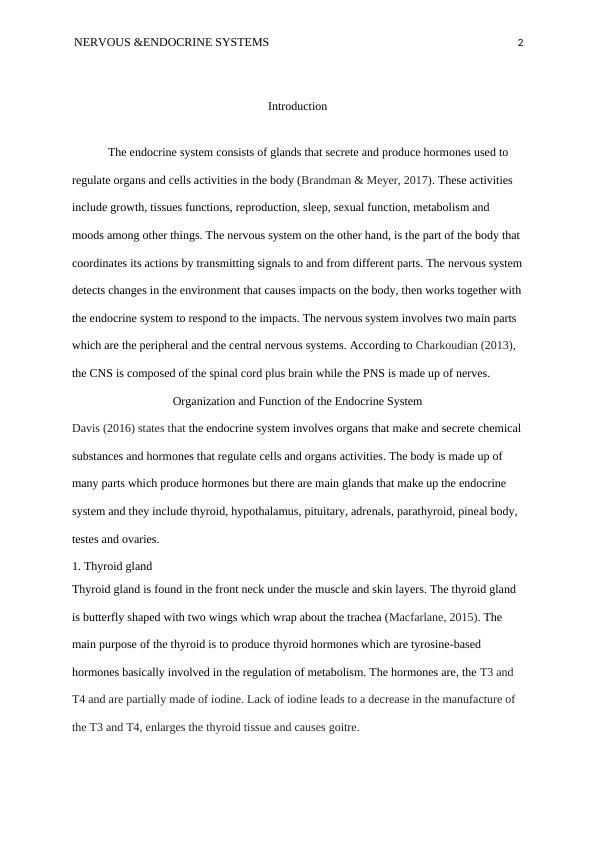Nervous and Endocrine systems, and Homeostatic Mechanisms
Added on 2023-05-29
10 Pages2081 Words397 Views
Running head: NERVOUS & ENDOCRINE SYSTEMS 1
Nervous and Endocrine systems, and Homeostatic Mechanisms.
Student’s Name
University Affiliate
Nervous and Endocrine systems, and Homeostatic Mechanisms.
Student’s Name
University Affiliate

NERVOUS &ENDOCRINE SYSTEMS 2
Introduction
The endocrine system consists of glands that secrete and produce hormones used to
regulate organs and cells activities in the body (Brandman & Meyer, 2017). These activities
include growth, tissues functions, reproduction, sleep, sexual function, metabolism and
moods among other things. The nervous system on the other hand, is the part of the body that
coordinates its actions by transmitting signals to and from different parts. The nervous system
detects changes in the environment that causes impacts on the body, then works together with
the endocrine system to respond to the impacts. The nervous system involves two main parts
which are the peripheral and the central nervous systems. According to Charkoudian (2013),
the CNS is composed of the spinal cord plus brain while the PNS is made up of nerves.
Organization and Function of the Endocrine System
Davis (2016) states that the endocrine system involves organs that make and secrete chemical
substances and hormones that regulate cells and organs activities. The body is made up of
many parts which produce hormones but there are main glands that make up the endocrine
system and they include thyroid, hypothalamus, pituitary, adrenals, parathyroid, pineal body,
testes and ovaries.
1. Thyroid gland
Thyroid gland is found in the front neck under the muscle and skin layers. The thyroid gland
is butterfly shaped with two wings which wrap about the trachea (Macfarlane, 2015). The
main purpose of the thyroid is to produce thyroid hormones which are tyrosine-based
hormones basically involved in the regulation of metabolism. The hormones are, the T3 and
T4 and are partially made of iodine. Lack of iodine leads to a decrease in the manufacture of
the T3 and T4, enlarges the thyroid tissue and causes goitre.
Introduction
The endocrine system consists of glands that secrete and produce hormones used to
regulate organs and cells activities in the body (Brandman & Meyer, 2017). These activities
include growth, tissues functions, reproduction, sleep, sexual function, metabolism and
moods among other things. The nervous system on the other hand, is the part of the body that
coordinates its actions by transmitting signals to and from different parts. The nervous system
detects changes in the environment that causes impacts on the body, then works together with
the endocrine system to respond to the impacts. The nervous system involves two main parts
which are the peripheral and the central nervous systems. According to Charkoudian (2013),
the CNS is composed of the spinal cord plus brain while the PNS is made up of nerves.
Organization and Function of the Endocrine System
Davis (2016) states that the endocrine system involves organs that make and secrete chemical
substances and hormones that regulate cells and organs activities. The body is made up of
many parts which produce hormones but there are main glands that make up the endocrine
system and they include thyroid, hypothalamus, pituitary, adrenals, parathyroid, pineal body,
testes and ovaries.
1. Thyroid gland
Thyroid gland is found in the front neck under the muscle and skin layers. The thyroid gland
is butterfly shaped with two wings which wrap about the trachea (Macfarlane, 2015). The
main purpose of the thyroid is to produce thyroid hormones which are tyrosine-based
hormones basically involved in the regulation of metabolism. The hormones are, the T3 and
T4 and are partially made of iodine. Lack of iodine leads to a decrease in the manufacture of
the T3 and T4, enlarges the thyroid tissue and causes goitre.

NERVOUS &ENDOCRINE SYSTEMS 3
2. Hypothalamus gland
Hypothalamus gland is found deep inside the brain and it controls the pituitary gland and also
produces releasing and inhibiting hormones. Together, pituitary and hypothalamus
communicate to the other endocrine glands in the body to release the hormones that defend
and affect every aspect of one’s health. Hypothalamus gland hormones include the anti-
diuretic, oxytocin corticotropin-releasing, and gonadotropin- releasing, growth-releasing,
somatostatin and the thyrotropin-releasing hormones. Corticotropin-releasing hormone leads
the body respond to emotional and physical stress, suppresses appetite and stimulates anxiety.
Anti-diuretic hormone regulates the levels of water in the body and affects blood volume and
pressure (Marieb & Hoehn, 2015)
3. Adrenals glands
Also referred to as suprarenal glands and produces a number of hormones including
adrenaline and steroids aldosterone. These glands are located above the kidneys and release
hormones into the bloodstream. Meier and Gressner (2014) states that, the adrenal glands
includes two parts namely the adrenal cortex and the medulla. The hormones produced by
adrenal glands are Mineralocorticoids which aids to reserve the body’s water and salt level
which then regulate blood pressure, the glucocorticoids that helps to regulate metabolism and
is involved in the reaction to illness, the adrenal androgens namely testosterone and
dehydroepiandrosterone which play a role in early growth of the male sex organs in
childhood and lastly the catecholamines produced by the medulla. The catecholamines are
involved in all the physical characteristics of the fight or flight reactions.
2. Hypothalamus gland
Hypothalamus gland is found deep inside the brain and it controls the pituitary gland and also
produces releasing and inhibiting hormones. Together, pituitary and hypothalamus
communicate to the other endocrine glands in the body to release the hormones that defend
and affect every aspect of one’s health. Hypothalamus gland hormones include the anti-
diuretic, oxytocin corticotropin-releasing, and gonadotropin- releasing, growth-releasing,
somatostatin and the thyrotropin-releasing hormones. Corticotropin-releasing hormone leads
the body respond to emotional and physical stress, suppresses appetite and stimulates anxiety.
Anti-diuretic hormone regulates the levels of water in the body and affects blood volume and
pressure (Marieb & Hoehn, 2015)
3. Adrenals glands
Also referred to as suprarenal glands and produces a number of hormones including
adrenaline and steroids aldosterone. These glands are located above the kidneys and release
hormones into the bloodstream. Meier and Gressner (2014) states that, the adrenal glands
includes two parts namely the adrenal cortex and the medulla. The hormones produced by
adrenal glands are Mineralocorticoids which aids to reserve the body’s water and salt level
which then regulate blood pressure, the glucocorticoids that helps to regulate metabolism and
is involved in the reaction to illness, the adrenal androgens namely testosterone and
dehydroepiandrosterone which play a role in early growth of the male sex organs in
childhood and lastly the catecholamines produced by the medulla. The catecholamines are
involved in all the physical characteristics of the fight or flight reactions.

End of preview
Want to access all the pages? Upload your documents or become a member.
Related Documents
Nursing Practice Knowledge and Care: Endocrine, Renal and Respiratory Systemslg...
|6
|1715
|458
The Endocrine System: Structure and Functionslg...
|9
|1463
|405
Human Biology- Endocrine Systemlg...
|7
|2040
|158
The Endocrine Systemlg...
|12
|2618
|89
The Endocrine System | Reportlg...
|4
|455
|22
Anatomy and Physiology | Assignmentlg...
|13
|4031
|46
